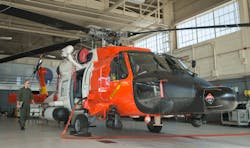Like the human nervous system, a Health and Usage Monitoring System (HUMS) allows a helicopter operator to get a feel for what is going on inside the body of their aircraft without opening it up.
“HUMS is a system that monitors the mechanical systems on an aircraft and can proactively identify damaged parts. HUMS systems can identify damaged parts by vibrational signatures and can also assess how quickly damage progresses. Using pre-determined thresholds, the system can detect damaged parts before they become a critical failure,” explained Kevin Hawko, associate director, Vehicle Health Business Development, Collins Aerospace.
A more advanced HUMS can synchronize health data with aircraft and engine operational parameters to allow fleet users to better understand when and how component damage occurs.
HUMS has numerous benefits for helicopter operators and maintenance, repair and overhaul (MRO) facilities, detailed Eric Bechhoefer, CEO and chief engineer, GPMS.
“A modern HUMS like Foresight MX goes beyond simply collecting and recording data. It provides comprehensive condition monitoring and provides visibility into the material condition of components on the aircraft, without invasive inspections, and allows us to project and predict the remaining useful life of a component,” he said.
Daniil Ravvin, offering manager of HUMS, Honeywell Aerospace, added: “The key benefit of HUMS is enhanced safety — safety of flight, aircraft and people. A proactive approach minimizes accidents before they happen. Data signaling potential problems on one aircraft can be used to comprehensively analyze an entire fleet.
“Another benefit is increased aircraft availability. Better maintenance planning means less unplanned downtime, faster turnaround and increased mission readiness to support operations.”
Despite the benefits, HUMS systems are not standard equipment for helicopters.
“Currently HUMS are considered non-standard equipment, but major helicopter OEMs are moving towards including HUMS as part of the offering, as well as government aviation entities providing mandates and regulations in design and usage of vehicle health systems,” added Ravvin.
While large, heavy and military aircraft have traditionally had HUMS installed at the factory, light and medium commercial aircraft have not. Bechhoefer said he estimates that roughly 80 percent of aircraft flying have no HUMS capability onboard.
Bring it Onboard
For maintenance operations, a HUMS system has tremendous potential, said Bechhoefer.
“By utilizing our Foresight MX technology, operators can preclude machine-related safety issues, improve availability and readiness of their vehicles and aircraft, and reduce maintenance costs by catching big/expensive issues early and speeding diagnosis. Foresight MX provides information on what is going on inside the engine, the gearbox, and vital components, so operators can see and know what is happening without unnecessary, invasive inspections,” he continued.
In general, HUMS monitors, gathers and evaluates the following types of data:
- Usage monitoring—Collection of events and times spent operating aircraft and subcomponents
- Exceedance monitoring—Detection of out-of-limits operational characteristics or parameters
- Data and event recording—The storage of raw and processed data, events and activities
- Balancing (rotor track and balance, shaft balance)—Smoothing and optimizing of vibrations
- Mechanical diagnostics (airframe, gearbox, shaft and bearings)—Analysis of rotating parts
- Data Integration—Consolidation of all available aircraft data
In short, cracks, chips, missing gear teeth, misalignment, out of balances, and similar findings can be diagnosed, pin-pointed and indicated for immediate repair.
“Collected data is balanced against a specific aircraft database. Depending on specifics of system set up, exceedance indicators alert pilots and maintenance personnel of critical conditions that should be addressed. With each flight/maintenance cycle, the collected data grows and is reviewed for improved and proactive aircraft repairs. HUMS data should be used during post-flight missions and analytics, as well as periodically, depending on environment, usage and aircraft type,” Ravvin said.
This data helps with early identification of damaged parts and can minimize unscheduled maintenance, improving dispatch rates. Operators can schedule repairs during routine maintenance checks, which reduces aircraft downtime and improves aircraft availability.
“In certain cases, the HUMS can be used to provide maintenance credit for specific components on a helicopter. In those instances, the components can be maintained on a condition basis or as-needed basis. This helps eliminate timely, manpower intensive component inspections,” Hawko adds.
The detailed and comprehensive information HUMS gives is also vital to the implementation of a safety management system, Bechhoefer added. Given not all aircraft are utilized the same, HUMS gives better insight into how each aircraft was flown, the usage or loads imposed on the aircraft and how maintenance was performed. HUMS collects this type of information and provides analysis to give operators confidence in their aircraft and their ability make their missions.
“Being proactive is the best approach to maintaining high standards of safety during operations. HUMS systems provide significant insights into health conditions of the aircraft. Continuous health monitoring needs to be utilized and aligned with operator usage and maintenance intervals. Such approach will prolong aircraft life, reduce overall maintenance cost, and improve safety assurances for customers and users,” Hawko said.
Bechhoefer also noted that the data lends itself perfectly to the digitization trend that is becoming more and more important in the maintenance of aircraft and management of MRO operations.
“If you have the data, you have the ability to better predict the performance of components over time. This allows you to better manage your maintenance and your logistics. Do you need to have a gearbox on hand? Do you need the large inventory? If you have the data, you can make better decisions,” said said.
HUMS-ing into the Future
While HUMS may not be standard equipment now, Bechhoefer said he sees it trending that way.
“All of that is changing, especially as contracting customers see the benefits of the technology and the cost and weight improvements make these systems more and more accessible. IOGP, BARS, USFS, and CAMTS have all put HUMS on their requirement roadmaps. So, it’s clear that HUMS will soon be a standard best practice,” he said.
Hawko said they too are anticipating that there will be more integration of aircraft health data into aircraft operations.
“For example, using the health of the aircraft as feedback to limit aircraft performance when component damage occurs. This will prevent further damage and improve operational safety,” he continued.
There is limitless growth in the UAV and UAM market to reinforce user safety, noted Ravvin, who predicts that such systems will trancend the aviation market as the technology evolves.
“HUMS is an incredibly useful and needed product, but like any another technology, the systems must keep up and be ahead of technological changes. Smarter sensors, faster data aggregation and larger data storage will continually be needed. HUMS will utilize faster cellular & SATCOM channels, as well as being more secure and immune to cyber threats,” Ravvin said.
“Additionally, there is potential in the rail and heavy trucking market. Overall, HUMS will become standard equipment in multiple segments of aviation, rail and transport industry.”
Today, Hawko said maintenance operations can get the most out of their systems by partnering with their HUMS and airframe providers to best align the data to their operations and integrate the health information into sustainment and maintenance practices.
“There is a lot that can be done with data presentation and visualization today than when these systems first were introduced. How the operator wants to view their data is key to optimizing operations. Also, by partnering with the HUMS provider, operators can get a complete understanding of what data and features are available. Again, having this understanding can help operators align operations and maintenance practices,” he said.


